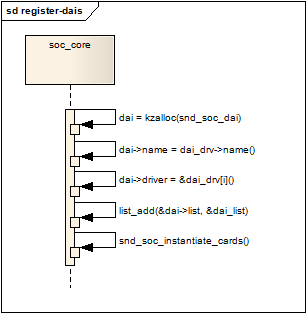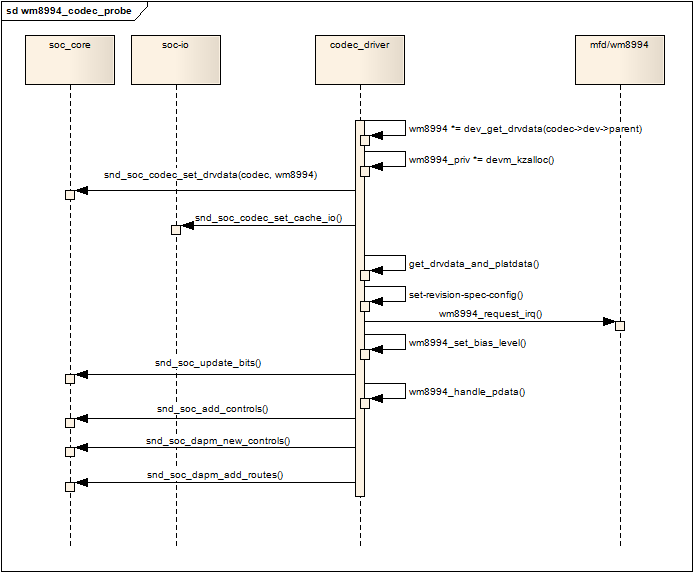Linux ALSA声卡驱动之七:ASoC架构中的Codec
2013-01-03 00:24
387 查看
1. Codec简介
在移动设备中,Codec的作用可以归结为4种,分别是:对PCM等信号进行D/A转换,把数字的音频信号转换为模拟信号
对Mic、Linein或者其他输入源的模拟信号进行A/D转换,把模拟的声音信号转变CPU能够处理的数字信号
对音频通路进行控制,比如播放音乐,收听调频收音机,又或者接听电话时,音频信号在codec内的流通路线是不一样的
对音频信号做出相应的处理,例如音量控制,功率放大,EQ控制等等
ASoC对Codec的这些功能都定义好了一些列相应的接口,以方便地对Codec进行控制。ASoC对Codec驱动的一个基本要求是:驱动程序的代码必须要做到平台无关性,以方便同一个Codec的代码不经修改即可用在不同的平台上。以下的讨论基于wolfson的Codec芯片WM8994,kernel的版本3.3.x。
/*****************************************************************************************************/
声明:本博内容均由http://blog.csdn.net/droidphone原创,转载请注明出处,谢谢!
/*****************************************************************************************************/
2. ASoC中对Codec的数据抽象
描述Codec的最主要的几个数据结构分别是:snd_soc_codec,snd_soc_codec_driver,snd_soc_dai,snd_soc_dai_driver,其中的snd_soc_dai和snd_soc_dai_driver在ASoC的Platform驱动中也会使用到,Platform和Codec的DAI通过snd_soc_dai_link结构,在Machine驱动中进行绑定连接。下面我们先看看这几个结构的定义,这里我只贴出我要关注的字段,详细的定义请参照:/include/sound/soc.h。snd_soc_codec:
[html] view
plaincopy
/* SoC Audio Codec device */
struct snd_soc_codec {
const char *name; /* Codec的名字*/
struct device *dev; /* 指向Codec设备的指针 */
const struct snd_soc_codec_driver *driver; /* 指向该codec的驱动的指针 */
struct snd_soc_card *card; /* 指向Machine驱动的card实例 */
int num_dai; /* 该Codec数字接口的个数,目前越来越多的Codec带有多个I2S或者是PCM接口 */
int (*volatile_register)(...); /* 用于判定某一寄存器是否是volatile */
int (*readable_register)(...); /* 用于判定某一寄存器是否可读 */
int (*writable_register)(...); /* 用于判定某一寄存器是否可写 */
/* runtime */
......
/* codec IO */
void *control_data; /* 该指针指向的结构用于对codec的控制,通常和read,write字段联合使用 */
enum snd_soc_control_type control_type;/* 可以是SND_SOC_SPI,SND_SOC_I2C,SND_SOC_REGMAP中的一种 */
unsigned int (*read)(struct snd_soc_codec *, unsigned int); /* 读取Codec寄存器的函数 */
int (*write)(struct snd_soc_codec *, unsigned int, unsigned int); /* 写入Codec寄存器的函数 */
/* dapm */
struct snd_soc_dapm_context dapm; /* 用于DAPM控件 */
};
snd_soc_codec_driver:
[html] view
plaincopy
/* codec driver */
struct snd_soc_codec_driver {
/* driver ops */
int (*probe)(struct snd_soc_codec *); /* codec驱动的probe函数,由snd_soc_instantiate_card回调 */
int (*remove)(struct snd_soc_codec *);
int (*suspend)(struct snd_soc_codec *); /* 电源管理 */
int (*resume)(struct snd_soc_codec *); /* 电源管理 */
/* Default control and setup, added after probe() is run */
const struct snd_kcontrol_new *controls; /* 音频控件指针 */
const struct snd_soc_dapm_widget *dapm_widgets; /* dapm部件指针 */
const struct snd_soc_dapm_route *dapm_routes; /* dapm路由指针 */
/* codec wide operations */
int (*set_sysclk)(...); /* 时钟配置函数 */
int (*set_pll)(...); /* 锁相环配置函数 */
/* codec IO */
unsigned int (*read)(...); /* 读取codec寄存器函数 */
int (*write)(...); /* 写入codec寄存器函数 */
int (*volatile_register)(...); /* 用于判定某一寄存器是否是volatile */
int (*readable_register)(...); /* 用于判定某一寄存器是否可读 */
int (*writable_register)(...); /* 用于判定某一寄存器是否可写 */
/* codec bias level */
int (*set_bias_level)(...); /* 偏置电压配置函数 */
};
snd_soc_dai:
[html] view
plaincopy
/*
* Digital Audio Interface runtime data.
*
* Holds runtime data for a DAI.
*/
struct snd_soc_dai {
const char *name; /* dai的名字 */
struct device *dev; /* 设备指针 */
/* driver ops */
struct snd_soc_dai_driver *driver; /* 指向dai驱动结构的指针 */
/* DAI runtime info */
unsigned int capture_active:1; /* stream is in use */
unsigned int playback_active:1; /* stream is in use */
/* DAI DMA data */
void *playback_dma_data; /* 用于管理playback dma */
void *capture_dma_data; /* 用于管理capture dma */
/* parent platform/codec */
union {
struct snd_soc_platform *platform; /* 如果是cpu dai,指向所绑定的平台 */
struct snd_soc_codec *codec; /* 如果是codec dai指向所绑定的codec */
};
struct snd_soc_card *card; /* 指向Machine驱动中的crad实例 */
};
snd_soc_dai_driver:
[html] view
plaincopy
/*
* Digital Audio Interface Driver.
*
* Describes the Digital Audio Interface in terms of its ALSA, DAI and AC97
* operations and capabilities. Codec and platform drivers will register this
* structure for every DAI they have.
*
* This structure covers the clocking, formating and ALSA operations for each
* interface.
*/
struct snd_soc_dai_driver {
/* DAI description */
const char *name; /* dai驱动名字 */
/* DAI driver callbacks */
int (*probe)(struct snd_soc_dai *dai); /* dai驱动的probe函数,由snd_soc_instantiate_card回调 */
int (*remove)(struct snd_soc_dai *dai);
int (*suspend)(struct snd_soc_dai *dai); /* 电源管理 */
int (*resume)(struct snd_soc_dai *dai);
/* ops */
const struct snd_soc_dai_ops *ops; /* 指向本dai的snd_soc_dai_ops结构 */
/* DAI capabilities */
struct snd_soc_pcm_stream capture; /* 描述capture的能力 */
struct snd_soc_pcm_stream playback; /* 描述playback的能力 */
};
snd_soc_dai_ops用于实现该dai的控制盒参数配置:
[html] view
plaincopy
struct snd_soc_dai_ops {
/*
* DAI clocking configuration, all optional.
* Called by soc_card drivers, normally in their hw_params.
*/
int (*set_sysclk)(...);
int (*set_pll)(...);
int (*set_clkdiv)(...);
/*
* DAI format configuration
* Called by soc_card drivers, normally in their hw_params.
*/
int (*set_fmt)(...);
int (*set_tdm_slot)(...);
int (*set_channel_map)(...);
int (*set_tristate)(...);
/*
* DAI digital mute - optional.
* Called by soc-core to minimise any pops.
*/
int (*digital_mute)(...);
/*
* ALSA PCM audio operations - all optional.
* Called by soc-core during audio PCM operations.
*/
int (*startup)(...);
void (*shutdown)(...);
int (*hw_params)(...);
int (*hw_free)(...);
int (*prepare)(...);
int (*trigger)(...);
/*
* For hardware based FIFO caused delay reporting.
* Optional.
*/
snd_pcm_sframes_t (*delay)(...);
};
3. Codec的注册
因为Codec驱动的代码要做到平台无关性,要使得Machine驱动能够使用该Codec,Codec驱动的首要任务就是确定snd_soc_codec和snd_soc_dai的实例,并把它们注册到系统中,注册后的codec和dai才能为Machine驱动所用。以WM8994为例,对应的代码位置:/sound/soc/codecs/wm8994.c,模块的入口函数注册了一个platform driver:[html] view
plaincopy
static struct platform_driver wm8994_codec_driver = {
.driver = {
.name = "wm8994-codec",
.owner = THIS_MODULE,
},
.probe = wm8994_probe,
.remove = __devexit_p(wm8994_remove),
};
module_platform_driver(wm8994_codec_driver);
有platform driver,必定会有相应的platform device,这个platform device的来源后面再说,显然,platform driver注册后,probe回调将会被调用,这里是wm8994_probe函数:
[html] view
plaincopy
static int __devinit wm8994_probe(struct platform_device *pdev)
{
return snd_soc_register_codec(&pdev->dev, &soc_codec_dev_wm8994,
wm8994_dai, ARRAY_SIZE(wm8994_dai));
}
其中,soc_codec_dev_wm8994和wm8994_dai的定义如下(代码中定义了3个dai,这里只列出第一个):
[html] view
plaincopy
static struct snd_soc_codec_driver soc_codec_dev_wm8994 = {
.probe = wm8994_codec_probe,
.remove = wm8994_codec_remove,
.suspend = wm8994_suspend,
.resume = wm8994_resume,
.set_bias_level = wm8994_set_bias_level,
.reg_cache_size = WM8994_MAX_REGISTER,
.volatile_register = wm8994_soc_volatile,
};
[html] view
plaincopy
static struct snd_soc_dai_driver wm8994_dai[] = {
{
.name = "wm8994-aif1",
.id = 1,
.playback = {
.stream_name = "AIF1 Playback",
.channels_min = 1,
.channels_max = 2,
.rates = WM8994_RATES,
.formats = WM8994_FORMATS,
},
.capture = {
.stream_name = "AIF1 Capture",
.channels_min = 1,
.channels_max = 2,
.rates = WM8994_RATES,
.formats = WM8994_FORMATS,
},
.ops = &wm8994_aif1_dai_ops,
},
......
}
可见,Codec驱动的第一个步骤就是定义snd_soc_codec_driver和snd_soc_dai_driver的实例,然后调用snd_soc_register_codec函数对Codec进行注册。进入snd_soc_register_codec函数看看:
首先,它申请了一个snd_soc_codec结构的实例:
[html] view
plaincopy
codec = kzalloc(sizeof(struct snd_soc_codec), GFP_KERNEL);
确定codec的名字,这个名字很重要,Machine驱动定义的snd_soc_dai_link中会指定每个link的codec和dai的名字,进行匹配绑定时就是通过和这里的名字比较,从而找到该Codec的!
[html] view
plaincopy
/* create CODEC component name */
codec->name = fmt_single_name(dev, &codec->id);
然后初始化它的各个字段,多数字段的值来自上面定义的snd_soc_codec_driver的实例soc_codec_dev_wm8994:
[html] view
plaincopy
codec->write = codec_drv->write;
codec->read = codec_drv->read;
codec->volatile_register = codec_drv->volatile_register;
codec->readable_register = codec_drv->readable_register;
codec->writable_register = codec_drv->writable_register;
codec->dapm.bias_level = SND_SOC_BIAS_OFF;
codec->dapm.dev = dev;
codec->dapm.codec = codec;
codec->dapm.seq_notifier = codec_drv->seq_notifier;
codec->dapm.stream_event = codec_drv->stream_event;
codec->dev = dev;
codec->driver = codec_drv;
codec->num_dai = num_dai;
在做了一些寄存器缓存的初始化和配置工作后,通过snd_soc_register_dais函数对本Codec的dai进行注册:
[html] view
plaincopy
/* register any DAIs */
if (num_dai) {
ret = snd_soc_register_dais(dev, dai_drv, num_dai);
if (ret < 0)
goto fail;
}
最后,它把codec实例链接到全局链表codec_list中,并且调用snd_soc_instantiate_cards是函数触发Machine驱动进行一次匹配绑定操作:
[html] view
plaincopy
list_add(&codec->list, &codec_list);
snd_soc_instantiate_cards();
上面的snd_soc_register_dais函数其实也是和snd_soc_register_codec类似,显示为每个snd_soc_dai实例分配内存,确定dai的名字,用snd_soc_dai_driver实例的字段对它进行必要初始化,最后把该dai链接到全局链表dai_list中,和Codec一样,最后也会调用snd_soc_instantiate_cards函数触发一次匹配绑定的操作。

图3.1 dai的注册
关于snd_soc_instantiate_cards函数,请参阅另一篇博文:Linux音频驱动之六:ASoC架构中的Machine。
4. mfd设备
前面已经提到,codec驱动把自己注册为一个platform driver,那对应的platform device在哪里定义?答案是在以下代码文件中:/drivers/mfd/wm8994-core.c。WM8994本身具备多种功能,除了codec外,它还有作为LDO和GPIO使用,这几种功能共享一些IO和中断资源,linux为这种设备提供了一套标准的实现方法:mfd设备。其基本思想是为这些功能的公共部分实现一个父设备,以便共享某些系统资源和功能,然后每个子功能实现为它的子设备,这样既共享了资源和代码,又能实现合理的设备层次结构,主要利用到的API就是:mfd_add_devices(),mfd_remove_devices(),mfd_cell_enable(),mfd_cell_disable(),mfd_clone_cell()。
回到wm8994-core.c中,因为WM8994使用I2C进行内部寄存器的存取,它首先注册了一个I2C驱动:
[html] view
plaincopy
static struct i2c_driver wm8994_i2c_driver = {
.driver = {
.name = "wm8994",
.owner = THIS_MODULE,
.pm = &wm8994_pm_ops,
.of_match_table = wm8994_of_match,
},
.probe = wm8994_i2c_probe,
.remove = wm8994_i2c_remove,
.id_table = wm8994_i2c_id,
};
static int __init wm8994_i2c_init(void)
{
int ret;
ret = i2c_add_driver(&wm8994_i2c_driver);
if (ret != 0)
pr_err("Failed to register wm8994 I2C driver: %d\n", ret);
return ret;
}
module_init(wm8994_i2c_init);
进入wm8994_i2c_probe()函数,它先申请了一个wm8994结构的变量,该变量被作为这个I2C设备的driver_data使用,上面已经讲过,codec作为它的子设备,将会取出并使用这个driver_data。接下来,本函数利用regmap_init_i2c()初始化并获得一个regmap结构,该结构主要用于后续基于regmap机制的寄存器I/O,关于regmap我们留在后面再讲。最后,通过wm8994_device_init()来添加mfd子设备:
[html] view
plaincopy
static int wm8994_i2c_probe(struct i2c_client *i2c,
const struct i2c_device_id *id)
{
struct wm8994 *wm8994;
int ret;
wm8994 = devm_kzalloc(&i2c->dev, sizeof(struct wm8994), GFP_KERNEL);
i2c_set_clientdata(i2c, wm8994);
wm8994->dev = &i2c->dev;
wm8994->irq = i2c->irq;
wm8994->type = id->driver_data;
wm8994->regmap = regmap_init_i2c(i2c, &wm8994_base_regmap_config);
return wm8994_device_init(wm8994, i2c->irq);
}
继续进入wm8994_device_init()函数,它首先为两个LDO添加mfd子设备:
[html] view
plaincopy
/* Add the on-chip regulators first for bootstrapping */
ret = mfd_add_devices(wm8994->dev, -1,
wm8994_regulator_devs,
ARRAY_SIZE(wm8994_regulator_devs),
NULL, 0);
因为WM1811,WM8994,WM8958三个芯片功能类似,因此这三个芯片都使用了WM8994的代码,所以wm8994_device_init()接下来根据不同的芯片型号做了一些初始化动作,这部分的代码就不贴了。接着,从platform_data中获得部分配置信息:
[html] view
plaincopy
if (pdata) {
wm8994->irq_base = pdata->irq_base;
wm8994->gpio_base = pdata->gpio_base;
/* GPIO configuration is only applied if it's non-zero */
......
}
最后,初始化irq,然后添加codec子设备和gpio子设备:
[html] view
plaincopy
wm8994_irq_init(wm8994);
ret = mfd_add_devices(wm8994->dev, -1,
wm8994_devs, ARRAY_SIZE(wm8994_devs),
NULL, 0);
经过以上这些处理后,作为父设备的I2C设备已经准备就绪,它的下面挂着4个子设备:ldo-0,ldo-1,codec,gpio。其中,codec子设备的加入,它将会和前面所讲codec的platform driver匹配,触发probe回调完成下面所说的codec驱动的初始化工作。
5. Codec初始化
Machine驱动的初始化,codec和dai的注册,都会调用snd_soc_instantiate_cards()进行一次声卡和codec,dai,platform的匹配绑定过程,这里所说的绑定,正如Machine驱动一文中所描述,就是通过3个全局链表,按名字进行匹配,把匹配的codec,dai和platform实例赋值给声卡每对dai的snd_soc_pcm_runtime变量中。一旦绑定成功,将会使得codec和dai驱动的probe回调被调用,codec的初始化工作就在该回调中完成。对于WM8994,该回调就是wm8994_codec_probe函数:
图5.1 wm8994_codec_probe
取出父设备的driver_data,其实就是上一节的wm8994结构变量,取出其中的regmap字段,复制到codec的control_data字段中;
申请一个wm8994_priv私有数据结构,并把它设为codec设备的driver_data;
通过snd_soc_codec_set_cache_io初始化regmap io,完成这一步后,就可以使用API:snd_soc_read(),snd_soc_write()对codec的寄存器进行读写了;
把父设备的driver_data(struct wm8994)和platform_data保存到私有结构wm8994_priv中;
因为要同时支持3个芯片型号,这里要根据芯片的型号做一些特定的初始化工作;
申请必要的几个中断;
设置合适的偏置电平;
通过snd_soc_update_bits修改某些寄存器;
根据父设备的platform_data,完成特定于平台的初始化配置;
添加必要的control,dapm部件进而dapm路由信息;
至此,codec驱动的初始化完成。
5. regmap-io
我们知道,要想对codec进行控制,通常都是通过读写它的内部寄存器完成的,读写的接口通常是I2C或者是SPI接口,不过每个codec芯片寄存器的比特位组成都有所不同,寄存器地址的比特位也有所不同。例如WM8753的寄存器地址是7bits,数据是9bits,WM8993的寄存器地址是8bits,数据也是16bits,而WM8994的寄存器地址是16bits,数据也是16bits。在kernel3.1版本,内核引入了一套regmap机制和相关的API,这样就可以用统一的操作来实现对这些多样的寄存器的控制。regmap使用起来也相对简单:为codec定义一个regmap_config结构实例,指定codec寄存器的地址和数据位等信息;
根据codec的控制总线类型,调用以下其中一个函数,得到一个指向regmap结构的指针:
struct regmap *regmap_init_i2c(struct i2c_client *i2c, const struct regmap_config *config);
struct regmap *regmap_init_spi(struct spi_device *dev, const struct regmap_config *config);
把获得的regmap结构指针赋值给codec->control_data;
调用soc-io的api:snd_soc_codec_set_cache_io使得soc-io和regmap进行关联;
完成以上步骤后,codec驱动就可以使用诸如snd_soc_read、snd_soc_write、snd_soc_update_bits等API对codec的寄存器进行读写了。
相关文章推荐
- Linux ALSA声卡驱动之七:ASoC架构中的Codec
- Linux ALSA声卡驱动之七:ASoC架构中的Codec
- Linux ALSA声卡驱动之七:ASoC架构中的Codec
- Linux ALSA声卡驱动之七:ASoC架构中的Codec
- Linux ALSA声卡驱动之七:ASoC架构中的Codec
- Linux ALSA声卡驱动之七:ASoC架构中的Codec
- Linux ALSA声卡驱动之七:ASoC架构中的Codec
- Linux ALSA声卡驱动之七:ASoC架构中的Codec
- Linux ALSA声卡驱动之七:ASoC架构中的Codec
- Linux ALSA声卡驱动之七:ASoC架构中的Codec
- Linux ALSA声卡驱动之七:ASoC架构中的Codec
- Linux ALSA声卡驱动之七:ASoC架构中的Codec
- Linux ALSA声卡驱动之七:ASoC架构中的Codec
- Linux ALSA声卡驱动之七:ASoC架构中的Codec
- Linux ALSA声卡驱动之七:ASoC架构中的Codec
- Linux ALSA声卡驱动之七:ASoC架构中的Codec
- Linux ALSA声卡驱动之七:ASoC架构中的Codec
- Linux ALSA声卡驱动之七:ASoC架构中的Codec
- Linux ALSA声卡驱动之七:ASoC架构中的Codec
- Linux ALSA声卡驱动之七:ASoC架构中的Codec
